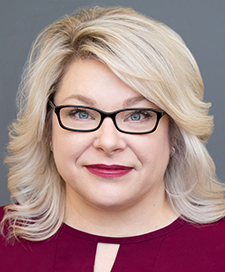While most people find extreme temperatures to be a hassle, for a growing portion of the population, extended heat waves or cold snaps can actually be deadly.
Poverty, chronic illness, poor body-temperature regulation and even cognitive decline can make climate change especially dangerous for older people. According to Climate Central, a nonprofit science news site, more than 80% of the estimated 12,000 people in the United States who die of heat-related causes each year are over age 60.
How can the people who love and care for older adults keep them safe when temperatures rise — or fall — to dangerous levels? I talked to Kari Everson, LeadingAge Minnesota vice president of clinical services and a licensed nursing home administrator, to get her insight on this issue.
Everson, whose decadeslong nursing career in senior-care facilities was inspired by an “Adopt A Grandparent” program in her Red Wing elementary school, emphasized the importance of building relationships and keeping a close eye on the older people in our lives. “The signs of heat-related illness can be really subtle,” she said. “It’s important to check in regularly, especially when the weather is extreme.”
MinnPost: Why are older adults more vulnerable to weather events?
Kari Everson: The body changes as we get older. There is loss of skin thickness, of fat stores, of the ability to control our own temperature. Because of those changes, older adults are less physically able to manage extreme heat or cold. Hypothermia and hyperthermia are more likely in elderly people. In long-term care facilities and nursing homes, residents with cognitive deficits are also less likely to understand the signals our bodies give us that tell us we are getting too hot or too cold, so they are at even greater risk of negative impact.
MinnPost: Since it’s summertime now, can you describe some of the negative physical impacts that extreme heat can have on older adults?
KE: In extreme heat events, older adults can have something called heat syncope. They can faint, and even have cardiac difficulties. Sometimes an older adult can get heat edema. They can also have muscle cramps, heat exhaustion or heatstroke. Those last two conditions are characterized by changes in behavior and exhaustion, especially during temperature extremes.
MinnPost: Is the impact of extreme weather the same for all older adults? What about people who live independently at home?

KE: It really depends on their health status. I know older people living at home, like my mother, who are generally healthy and don’t have cognitive disabilities, or my father-in-law, who is in his 80s and is physically healthy and cognitively sharp. People like them who live at home and are still able to care for themselves are at much lower risk of suffering physical consequences from extreme weather.
MinnPost: What are some things that friends or family can do to make sure that the older adults in their lives stay healthy during extreme weather events?
KE: If you are an older adult, or if you have an older adult relative who is living alone at home, the very best thing for them to do during extreme heat is to drink lots and lots of fluids. Year-round, older adults can more easily dehydrate than younger people. Dehydration can be dangerous in the colder months, but in summer, it is even more risky. When it’s really hot out, older adults should also limit their caffeine or alcohol consumption. Those substances can be dehydrating. And if an older adult is going outside, make sure to wear sunscreen. Sunburn can intensify the physical impact of high temperatures.
MinnPost: What are some measures that staff at nursing homes and long-term care facilities take to keep residents safe during extreme weather events?
KE: In nursing homes, our response to extreme weather is very involved. The kitchen staff, administration and nursing teams all pay close attention to residents during severe hot and cold weather. In extreme heat, they are asked to push a lot of fluids. They make sure to keep popsicles on hand. Many older adults generally don’t consume liquids in great quantities like younger people do. During extreme heat it is especially important to stay hydrated, so staff members do whatever they can to up residents’ fluid intake.
MinnPost: I have childhood memories of my grandmother wearing a sweater in the middle of a heat wave. Why was that?
KE: Even in hot weather, many older adults will say they are cold because of their skin frailty or fat loss. In nursing homes, we try to focus on person-centered care, working to anticipate what residents need. We try to observe any weather-related behavior or physical changes, like people looking flushed or acting dizzy. We also check their clothing to make sure they have lighter garments on.
MinnPost: It’s hard to imagine right now, but what about extreme cold weather events? What do nursing home staff do to protect residents during those events?
KE: I think that cold weather is a little less difficult in Minnesota because those of us who have grown up here recognize it is cold and know not to go outside on the worst days. We have electronic door monitors that alert us when residents with cognitive deficits go outside. The biggest risk in facilities is if our heating systems were to go out. So we make plans like keeping hot packs and extra blankets on hand. We also have evacuation plans lined up for hot and cold weather in case we need to evacuate and find a safe place for residents. We try to anticipate these events before they happen.